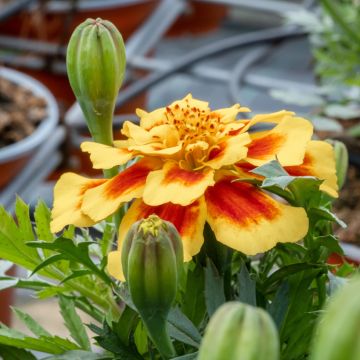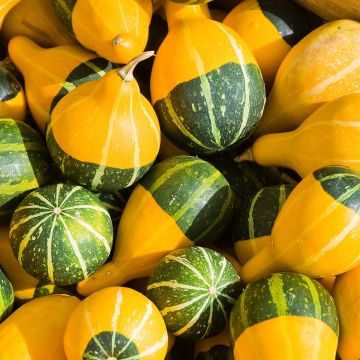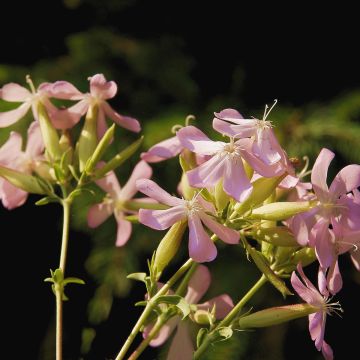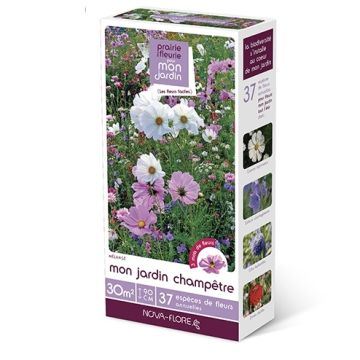Shipping country and language
Your country of residence may be:
Your country of residence is:
For a better user experience on our website, you can select:
Your shipping country:
Andorra
Austria
Belgium
Bulgaria
Canada
Chile
Croatia
Cyprus
Czechia
Denmark
Estonia
Finland
France
Germany
Greece
Hungary
Iceland
Ireland
Italy
Latvia
Lithuania
Luxembourg
Malta
Monaco
Netherlands
Poland
Portugal
Romania
Slovakia
Slovenia
Spain
Sweden
Switzerland
United Kingdom
We only deliver seed and bulb products to your country. If you add other products to your basket, they cannot be shipped.
Language:
French
German
Spanish
English
My Account
Hello
My wish lists
Plantfit
Log in / Register
Existing customer?
New customer?
Create an account to track your orders, access our customer service and, if you wish, make the most of our upcoming offers.
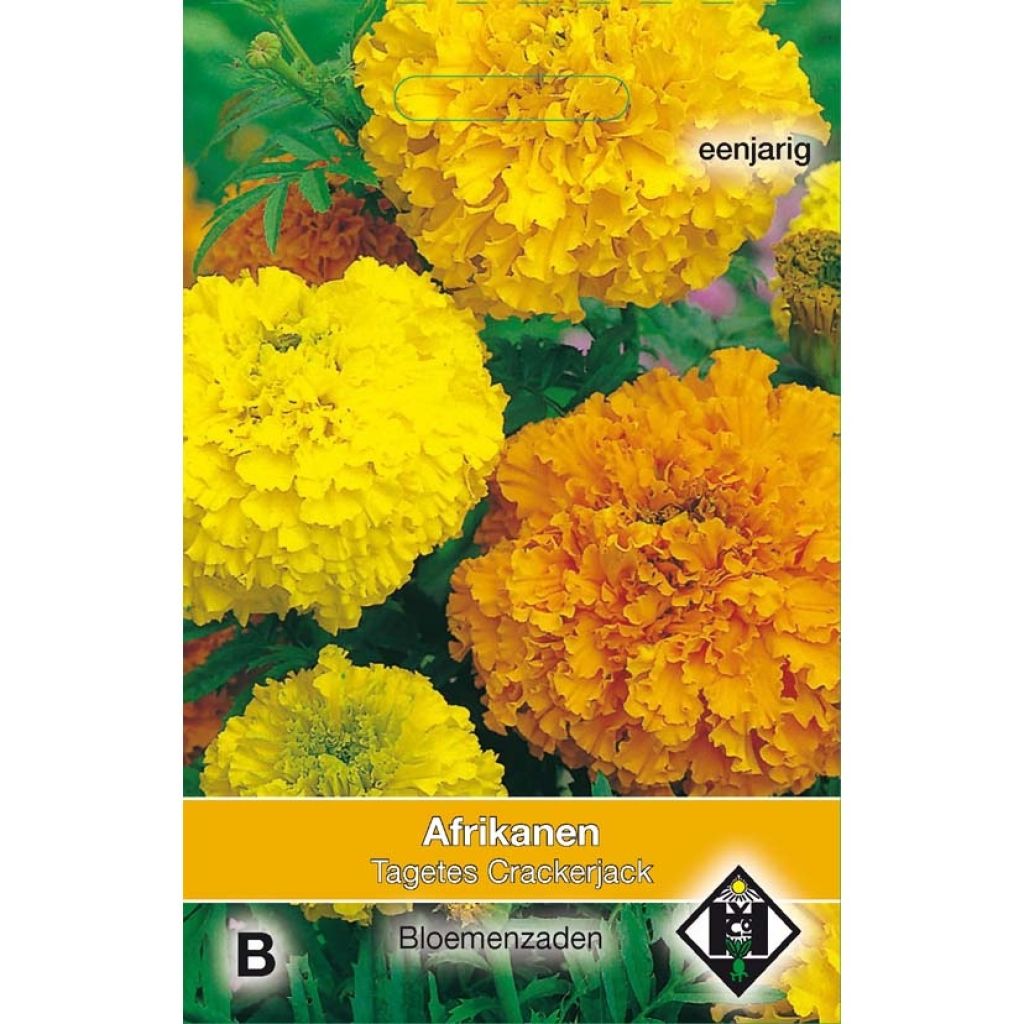

African Marigold Crackerjack Mix Seeds - Tagetes erecta
African Marigold Crackerjack Mix Seeds - Tagetes erecta
Tagetes erecta Crackerjack
African Marigold, Aztec Marigold, American Marigold
I have already sown the seeds of this flower last year. I gave some young plants to a friend. It is so beautiful that other neighbours are asking for some. (I am making more of them this year). A big thank you to the person who packed my parcel of young plants and who very carefully protected the seeds from the water of the neighbouring plants.
Sonia, 23/04/2023
Order in the next for dispatch today!
Dispatch by letter from €3.90.
Delivery charge from €5.90 Oversize package delivery charge from €6.90.
More information
This item is not available in your country.
Schedule delivery date,
and select date in basket
This plant carries a 6 months recovery warranty
More information
We guarantee the quality of our plants for a full growing cycle, and will replace at our expense any plant that fails to recover under normal climatic and planting conditions.
Seed-only orders are dispatched by sealed envelope. The delivery charge for seed-only orders is €3.90.
Does this plant fit my garden?
Set up your Plantfit profile →
Description
'Crackerjack Mix' is a classic selection that is still popular thanks to its exceptional vigour and brightly coloured double blooms. The large, bushy plants feature tightly packed pompoms from June to October, varying in colour from lemon yellow to vivid orange. Heat and weather resistant, floriferous, these superb annuals really bring summer bedding schemes to life. Grow in well-drained soil, in full sun to part shade.
Tagetes erecta, commonly known as African Marigold, is a tender herbaceous annual that belongs to the Asteraceae family. It is native to Mexico, Central America and the western regions of South America. It is not cold hardy and is generally treated as an annual in colder climates. 'Crackerjack' quickly forms an erect clump, about 90 cm tall for a spread of about 40 cm, covered with dark green, deeply divided, shiny leaves with an intense aroma. It flowers approximately 60 days after sowing. The flowering period lasts many weeks from June to October, providing spent flowers are removed regularly. This variety features fully double, pompom-like flowerheads that measure about 10 cm in diameter. They are composed of numerous very wavy, bright yellow ray flowers that range in colour from light yellow to vivid orange.
African marigolds are brightly coloured, cheerful annuals that are easy to grow, perfect for summer beds! They can be planted alongside perennials, annuals and even small shrubs; ornamental grasses will soften their flamboyant colours. Their abundant orange, yellow or red blooms mix well with blue-flowering catmints and perennial flax or poppies.
Good to know: The intensely scented leaves and the substances secreted by marigold roots repel various harmful insects, making marigolds an excellent companion plant in the vegetable garden.
Flowering
Foliage
Plant habit
Botanical data
Tagetes
erecta
Crackerjack
Asteraceae
African Marigold, Aztec Marigold, American Marigold
Cultivar or hybrid
Other Thompson and Morgan seeds
Planting and care
Sowing:
Sow from February to April.
Sow on the surface of a special sowing compost, moist and well-drained. Cover the seeds with a very thin layer of vermiculite or compost. Place the seedlings in a mini greenhouse or enclose them in a polyethylene bag at a constant temperature of 20 to 25°C until germination, which usually takes 7 to 21 days. Do not deprive them of light, as this promotes germination.
When the young plants are large enough to handle, transplant them into a tray or 8 cm pots. Acclimate them to cooler conditions for 10 to 15 days before watering and planting them outside at a distance of 15 - 20 cm, as soon as the risk of frost has passed.
In our moderately cold regions, you can also sow directly in the ground in April, as soon as the risk of frost has passed. Thin out your sowing, leaving only one plant every 20 cm.
Cultivation:
These fast-growing plants thrive in sunny and warm locations. Plant them in fertile, well-drained, and light soil. They are quite drought-resistant. Avoid excessive watering in summer, as it promotes the development of fungal diseases and root rot. Regularly remove faded flowers to prolong the flowering period. Protect the plants from slugs and snails, as they are fond of them. Tagetes cannot tolerate frost.
Sowing period
Intended location
- , onOrder confirmed
Reply from on Promesse de fleurs
Flower seeds
Haven't found what you were looking for?
Hardiness is the lowest winter temperature a plant can endure without suffering serious damage or even dying. However, hardiness is affected by location (a sheltered area, such as a patio), protection (winter cover) and soil type (hardiness is improved by well-drained soil).

Photo Sharing Terms & Conditions
In order to encourage gardeners to interact and share their experiences, Promesse de fleurs offers various media enabling content to be uploaded onto its Site - in particular via the ‘Photo sharing’ module.
The User agrees to refrain from:
- Posting any content that is illegal, prejudicial, insulting, racist, inciteful to hatred, revisionist, contrary to public decency, that infringes on privacy or on the privacy rights of third parties, in particular the publicity rights of persons and goods, intellectual property rights, or the right to privacy.
- Submitting content on behalf of a third party;
- Impersonate the identity of a third party and/or publish any personal information about a third party;
In general, the User undertakes to refrain from any unethical behaviour.
All Content (in particular text, comments, files, images, photos, videos, creative works, etc.), which may be subject to property or intellectual property rights, image or other private rights, shall remain the property of the User, subject to the limited rights granted by the terms of the licence granted by Promesse de fleurs as stated below. Users are at liberty to publish or not to publish such Content on the Site, notably via the ‘Photo Sharing’ facility, and accept that this Content shall be made public and freely accessible, notably on the Internet.
Users further acknowledge, undertake to have ,and guarantee that they hold all necessary rights and permissions to publish such material on the Site, in particular with regard to the legislation in force pertaining to any privacy, property, intellectual property, image, or contractual rights, or rights of any other nature. By publishing such Content on the Site, Users acknowledge accepting full liability as publishers of the Content within the meaning of the law, and grant Promesse de fleurs, free of charge, an inclusive, worldwide licence for the said Content for the entire duration of its publication, including all reproduction, representation, up/downloading, displaying, performing, transmission, and storage rights.
Users also grant permission for their name to be linked to the Content and accept that this link may not always be made available.
By engaging in posting material, Users consent to their Content becoming automatically accessible on the Internet, in particular on other sites and/or blogs and/or web pages of the Promesse de fleurs site, including in particular social pages and the Promesse de fleurs catalogue.
Users may secure the removal of entrusted content free of charge by issuing a simple request via our contact form.
The flowering period indicated on our website applies to countries and regions located in USDA zone 8 (France, the United Kingdom, Ireland, the Netherlands, etc.)
It will vary according to where you live:
- In zones 9 to 10 (Italy, Spain, Greece, etc.), flowering will occur about 2 to 4 weeks earlier.
- In zones 6 to 7 (Germany, Poland, Slovenia, and lower mountainous regions), flowering will be delayed by 2 to 3 weeks.
- In zone 5 (Central Europe, Scandinavia), blooming will be delayed by 3 to 5 weeks.
In temperate climates, pruning of spring-flowering shrubs (forsythia, spireas, etc.) should be done just after flowering.
Pruning of summer-flowering shrubs (Indian Lilac, Perovskia, etc.) can be done in winter or spring.
In cold regions as well as with frost-sensitive plants, avoid pruning too early when severe frosts may still occur.
The planting period indicated on our website applies to countries and regions located in USDA zone 8 (France, United Kingdom, Ireland, Netherlands).
It will vary according to where you live:
- In Mediterranean zones (Marseille, Madrid, Milan, etc.), autumn and winter are the best planting periods.
- In continental zones (Strasbourg, Munich, Vienna, etc.), delay planting by 2 to 3 weeks in spring and bring it forward by 2 to 4 weeks in autumn.
- In mountainous regions (the Alps, Pyrenees, Carpathians, etc.), it is best to plant in late spring (May-June) or late summer (August-September).
The harvesting period indicated on our website applies to countries and regions in USDA zone 8 (France, England, Ireland, the Netherlands).
In colder areas (Scandinavia, Poland, Austria...) fruit and vegetable harvests are likely to be delayed by 3-4 weeks.
In warmer areas (Italy, Spain, Greece, etc.), harvesting will probably take place earlier, depending on weather conditions.
The sowing periods indicated on our website apply to countries and regions within USDA Zone 8 (France, UK, Ireland, Netherlands).
In colder areas (Scandinavia, Poland, Austria...), delay any outdoor sowing by 3-4 weeks, or sow under glass.
In warmer climes (Italy, Spain, Greece, etc.), bring outdoor sowing forward by a few weeks.
